Cambrai Historic Textile
Town Medieval religious
centre Religious life in
Cambrai: music, pilgrims, festivals Their donations made it a great source of
wealth to the church. The Icon still attracts thousands of
pilgrims every year, and is shown in festivals on 15 May and
15 August every year
(left). The Bishopric of Cambrai was fought over
by its powerful neighbours - France, Burgundy, and the Holy
Roman Empire (Germany). Cambrai needed to be stongly
fortified. During the wars between Spain and France
for possession of the Low Countries, Cambrai's Archbishop
Fenellon: the "Swan of Cambrai" became known for his charity
as people fled for safety to Cambrai. In 1677, the city
itself was besieged and taken by Louis XIV; the Treaty of
Nijmegen, signed in 1678, finally assigned Cambrai to
France. During the French Revolution, in 1793,
the town's cathedral was destroyed. The present
Cathedral of Notre-Dame was built in the 19th
century. War
damage The town was over-run and occupied by the
German invasion in 1914, During the First World War,
Hindenburg made his HQ in Cambrai, behind an immensely
strong defence line along the St.Quentin Canal. In 1917, the British army successfully
used tanks in battle for the first time, achieving a
breakthrough in the German lines at Cambrai. In 1918 the
retreating Germans set fire to the town. Town of
Sugar Cambrai's food specialities are small
chitterling sausages (andouillettes), and
mint-flavoured sweets, the Bêtises de Cambrai -
sold all over France. An annual Festival celebrates all the
confectionary specialities of France, particularly the
famous Bêtises
- mint humbugs with a yellow stripe.

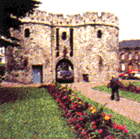
The Gate de Paris (1390), one of the
few remaining parts of the medieval town fortifications
(below).
Cambrai has been a textile town since the 14th century. It
was famous for its fine linen - "Cambric" - used for
handkerchiefs and fine underwear. The area still has many
textile factories, some with factory shops where you can
pick up household linens, sheets and bedding, towels,
bathrobes, socks and nightwear at bargain prices.
In the Middle Ages Cambrai was ruled by its Bishop, rather
like the Pope rules Vatican City. The Church was so wealthy
from its lands around Cambrai that the town citizens paid no
taxes - but they had no say in governing the city, so there
was friction between townsfolk and clergy. Cambrai's 12th
century Cathedral was completed in 1472, when it was said to
be "the marvel of the Low Countries". The Cathedral
was famous for its music, and gave high offices to
celebrated composers like Guillaume Dufoy and
Nicholas Grenon: both also served the Burgundian
court.
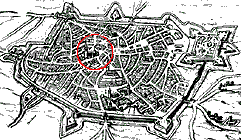
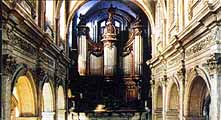
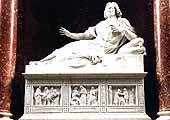
1.16th
century Spanish fortifications against the French (Cathedral
circled in red)
2.
Famous organ in Cambrai cathedral, rebuilt 1897 after a fire
in 1859. Well-suited to the acoustics of the lofty stone
Cathedral.
3. Archbishop Mothe Fenellon's tomb: he was
Archbishop 1695-1715 whilst wars raged through the
region.
Back to
top
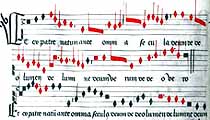
Celebrated music composed by Guillaume Dufay
(1397-1474) as Chapel Master for performing in Cambrai
Cathedral included Masses chansons and hymns.
Guillaume Dufoy was born in
Flanders, worked in Italy for years, and came back to
Cambrai Cathedral at the height of his fame. He composed
innovative choral works which are said to mark the dawn of
the Renaissance in Western European music.
![]()
The Icon of Notre Dame de Grâce is one of the
treasures of Cambrai's cathedral. It was brought from
Rome and installed in Cambrai Cathedral in 1452.
This strikingly vivid representation
of the Virgin Mary and Baby Jesus attracted famous pilgrims
such as Dukes of Burgundy, Kings of France (Louis XI,
François 1, Henri IV, Louis XIV), and Emperors
Maximilien and Charles Quint - also many thousands of humble
people.
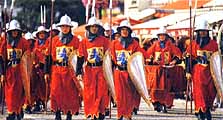
TODAY:
every 15 August, visitors flock to Cambrai to see the
traditional Notre Dame de Grâce procession,
with the town giants, Martin and Martine - part of a
week-long carnival, with fairground, fireworks, concerts and
competitions.

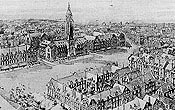
2.
Cambrai's old cathedral ablaze during incendiary shelling
3.
1920 plan for post-war reconstruction of the town hall
belfry and main square
Once a fortified town, Cambrai's town walls were mostly
demolished at the end of the 19th century - but some of the
gates and towers were saved.
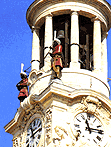
Above the Town Hall clock two 16th century wooden
blacksmiths, Martin and Martine, move on the
hour to strike bells with their hammers. The same characters
also appear in parades as the town's
"giants".
The area round Cambrai is fertile farmland - some of the
richest in France, used for growing sugar-beet and cereals.

Symbol of the annual Friandises
- the "Festival des Villes Sucrées" - held each
March
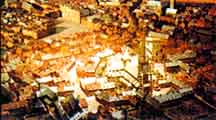 Cambrai's history told in a 30 min. sound and light show, using the finely-detailed model of the town in the early 18th century - in Cambrai Fine Arts Museum. |
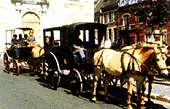 1. Tour the town in a horse-drawn carriage |
|
Weblinks
and more information |
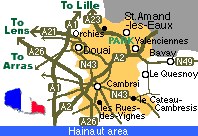 Click on places on map for more information |
|
Guillaume Dufoy,
church musician at Cambrai: |
|
|
Places
to visit |
|
|
http://www.crt-nord.fr/an/villes [in English] |
|
|
Background
Information: |
 QUICK TOUR round Hainaut region, starting with Historic Mining Centre... |
|
|
|
|
|
|
|
|
|